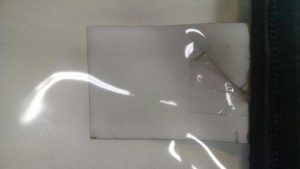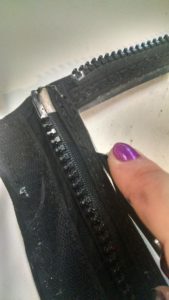We recently had a customer contact us about possible window  replacements. So we went out to their boat in storage to check out each panel and see what ones we needed to bring back to the shop to replace. Only two windows had makeshift patches on them. The customer used tape and stickers to help prevent water leakage for the time being. This is a great solution, by the way, for a temporary fix until you
replacements. So we went out to their boat in storage to check out each panel and see what ones we needed to bring back to the shop to replace. Only two windows had makeshift patches on them. The customer used tape and stickers to help prevent water leakage for the time being. This is a great solution, by the way, for a temporary fix until you  can get a hold of your local canvas shop to either ad a patch to the window, or replace the whole window itself with new glass.
can get a hold of your local canvas shop to either ad a patch to the window, or replace the whole window itself with new glass.
There are a couple different ways to do window replacements. It all really depends on the weather, and what shape your canvas is in. If its super hot outside, chances are your canvas has a lot of stretch to it. It’s probably easier to put on your boat because the fibers are more relaxed because of the heat. If it’s colder your canvas will be a little more hard and less likely to be so stretchy.
This canvas was in pretty good shape and looked rather new. Since  it’s winter right now and it’s cold, this canvas wasn’t so stretched out. So we were able to do them both in a couple of hours without having to run back out to the boat and take 3D measurements.
it’s winter right now and it’s cold, this canvas wasn’t so stretched out. So we were able to do them both in a couple of hours without having to run back out to the boat and take 3D measurements.
So we cut out the old windows out, first using a utility knife to get as close as we can to the edge of the canvas. Then we get in there with a pair of scissors and do the rest of the cutting, the same way, as close as possible to the edge. We want your new windows to look as if, they were magically fixed and like no work was done on them, so this part is very important.
After we cut out the old glass, we roll out the new glass and trace out the old windows onto the new glass. There are a few different kinds of glass you can choose. The differences vary in price and quality, as well as how long it’ll stay clear and thickness. This customer chose Strataglass. So we trace out the old glass onto the new glass to use as a reference point as to where the new window needs to line up, that way it fits perfectly. We carefully add an inch of glass around the line we just traced for a seam allowance. Then we put seamstick, which is a double sided sticky tape on the outside of the window where our seamstress will be sewing. Seamstick is just an extra precaution to help prevent water leakage through the needle holes of our sewing. Over time, dirt gets stuck in the holes, and since theres something sticky underneath, it helps block them up, which helps prevent any water from going through the holes. After we apply the seamstick, we line the windows up in the correct spot and sew them in!
the new glass to use as a reference point as to where the new window needs to line up, that way it fits perfectly. We carefully add an inch of glass around the line we just traced for a seam allowance. Then we put seamstick, which is a double sided sticky tape on the outside of the window where our seamstress will be sewing. Seamstick is just an extra precaution to help prevent water leakage through the needle holes of our sewing. Over time, dirt gets stuck in the holes, and since theres something sticky underneath, it helps block them up, which helps prevent any water from going through the holes. After we apply the seamstick, we line the windows up in the correct spot and sew them in!


Chicago Marine Canvas | Custom Boat Covers
Providing Custom Yacht & Boat Canvas, Covers and Repairs to the Chicago Boating Community